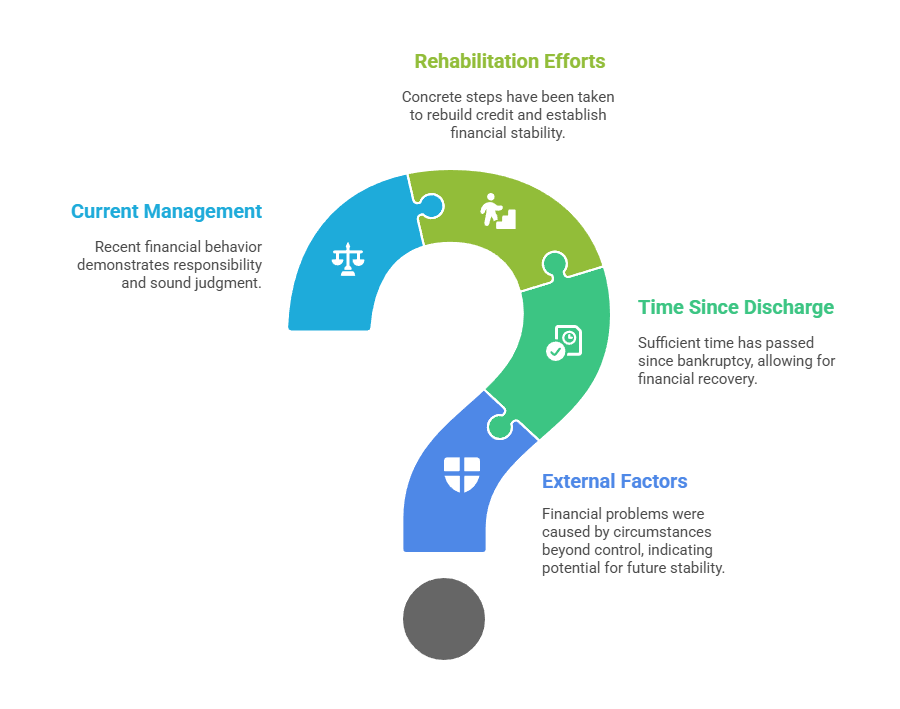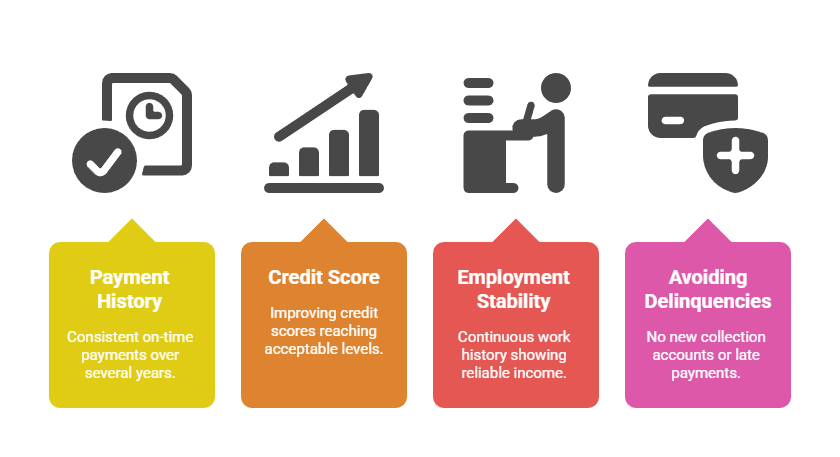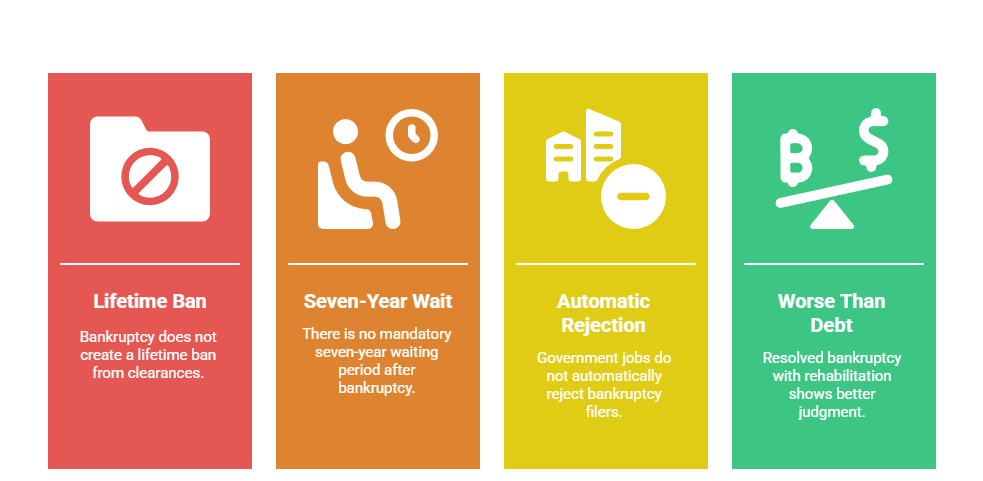Bankruptcy does not automatically disqualify candidates from government employment or security clearances. However, its impact varies significantly based on clearance level, time since discharge, financial rehabilitation efforts, and specific agency screening standards. Understanding the nuanced timeline approach and documentation requirements helps HR professionals and security officers make informed, compliant hiring decisions while avoiding common misconceptions about bankruptcy-related employment restrictions.
Key Takeaways
- Bankruptcy itself is not an automatic disqualifier for government employment or security clearances, though it becomes one factor in a holistic adjudication process that evaluates an applicant's overall financial responsibility and trustworthiness.
- The impact of bankruptcy on clearance eligibility decreases substantially over time, with candidates demonstrating financial rehabilitation and 2-3 years post-discharge showing significantly improved approval rates compared to recent filings.
- Secret clearance applications face less stringent financial scrutiny than Top Secret or Sensitive Compartmented Information (SCI) clearances, where bankruptcy receives more intensive review and longer evaluation periods.
- Government contractors and defense industry employers may apply additional bankruptcy screening standards beyond federal requirements, creating variations in how different agencies and private sector partners assess financial history.
- Documented financial rehabilitation—including credit counseling completion, consistent payment history, emergency fund establishment, and debt reduction efforts—strengthens clearance applications and demonstrates renewed financial responsibility.
- Different bankruptcy chapters (Chapter 7, 11, or 13) receive different considerations during adjudication, with Chapter 13 repayment plans sometimes viewed more favorably than Chapter 7 liquidations when the bankruptcy resulted from circumstances beyond the applicant's control.
- HR professionals must follow Fair Credit Reporting Act (FCRA) requirements when obtaining bankruptcy information through background checks, including providing pre-adverse action notices if bankruptcy history influences hiring decisions.
- Common myths persist about lifetime bans and automatic denials, but current adjudicative guidelines focus on recent financial behavior, rehabilitation efforts, and the underlying circumstances that led to bankruptcy rather than the filing itself.
Understanding Bankruptcy's Role in Government Employment Decisions
The relationship between bankruptcy and government employment is more nuanced than many HR professionals and security officers realize. Financial difficulties can raise legitimate security concerns, yet bankruptcy alone does not create an automatic bar to federal employment or security clearance eligibility. The key lies in understanding how adjudicators evaluate bankruptcy within the broader context of an applicant's financial responsibility, trustworthiness, and overall character.
Government agencies follow structured adjudicative guidelines rather than arbitrary rules when reviewing candidates with bankruptcy history. These guidelines recognize that financial difficulties can result from circumstances beyond an individual's control. Medical emergencies, divorce, job loss, or other life-altering events often trigger financial crises that lead to bankruptcy filing.
The evaluation focuses on several critical factors:

- Circumstances leading to bankruptcy: Were financial problems caused by factors beyond the applicant's control or by poor financial management?
- Time elapsed since discharge: How many years have passed since the bankruptcy was finalized?
- Financial rehabilitation efforts: Has the individual taken concrete steps to rebuild credit and establish financial stability?
- Current financial management: Does recent financial behavior demonstrate responsibility and sound judgment?
The Adjudicative Guidelines Framework
Current adjudicative guidelines provide a structured approach for evaluating financial considerations in security clearance decisions. Guideline F (Financial Considerations) specifically addresses how adjudicators should assess bankruptcy and other financial issues. This framework acknowledges that while financial problems may indicate poor judgment, they must be evaluated in context.
Adjudicators consider multiple factors when reviewing bankruptcy history. First, they examine whether financial issues represent recent problems or isolated incidents versus ongoing patterns. Evaluators also determine whether conditions causing financial problems were largely beyond the person's control. Additionally, adjudicators assess whether the individual has received financial counseling and established a clear plan to resolve financial problems.
Agency-Specific Variations in Screening Standards
Federal adjudicative guidelines provide overarching standards, but individual agencies may apply additional screening considerations. The Department of Defense, intelligence community agencies, Department of Energy facilities, and law enforcement agencies each maintain unique security cultures. These organizational differences can influence how bankruptcy history is weighted during clearance adjudication.
Some agencies with particularly sensitive missions conduct more intensive financial reviews. Others with less sensitive positions may apply more flexible standards. Government contractors operating in defense and intelligence sectors often align their internal screening policies with the most stringent government agency standards they support.
Clearance Level Differences: How Bankruptcy Impact Varies by Security Classification
The impact of bankruptcy on clearance eligibility varies substantially based on the level of access required. Understanding these distinctions helps HR professionals set realistic expectations with hiring managers and candidates. This knowledge also prevents unnecessary elimination of qualified applicants who may be eligible for certain clearance levels despite financial history.
| Clearance Level | Financial Scrutiny Intensity | Typical Post-Bankruptcy Timeline | Investigation Depth |
| Secret | Moderate | 2-3 years optimal | Credit checks, financial questionnaires |
| Top Secret | High | 3-5 years optimal | Detailed credit analysis, in-person interviews |
| SCI | Very High | 3-5 years optimal | Comprehensive financial review, reference interviews |
Secret clearances represent the most common security clearance level across government and contractor positions. These clearances generally involve less intensive financial scrutiny than higher classifications. Candidates with bankruptcy history who demonstrate financial rehabilitation often successfully obtain Secret clearances, particularly when several years have passed since discharge.
Top Secret and SCI Clearance Financial Reviews
Top Secret and Sensitive Compartmented Information (SCI) clearances require significantly more comprehensive financial reviews. These investigations involve more detailed credit analysis and in-person interviews about financial history. Investigators may also conduct interviews with references who can speak to the applicant's financial responsibility.
Bankruptcy receives more intensive scrutiny at these levels because the access granted involves highly sensitive national security information. Foreign intelligence services or other adversaries might attempt to exploit financial vulnerabilities. Therefore, candidates should expect detailed questions about circumstances leading to bankruptcy, steps taken toward financial rehabilitation, and current financial management practices.
Public Trust Positions and Financial Screening
Public Trust positions, while not requiring formal security clearances, often involve financial screening that considers bankruptcy history. These positions include roles handling sensitive information, financial responsibilities, or access to critical systems. Background investigations for these positions may include credit checks and financial questionnaires.
Standards applied to Public Trust positions typically fall between standard employment screening and Secret clearance requirements. Bankruptcy alone rarely disqualifies candidates for these roles. However, patterns of financial irresponsibility, ongoing unresolved debts, or evidence of financial mismanagement may raise concerns.
The Timeline Approach: How Time Since Discharge Affects Eligibility
Time elapsed since bankruptcy discharge represents one of the most critical factors in clearance adjudication and employment screening decisions. No official waiting period exists that guarantees clearance approval. Nevertheless, statistical patterns and case precedents demonstrate that longer post-discharge periods with demonstrated financial responsibility significantly improve approval likelihood.
Candidates face the most challenging environment for clearance applications during the first 6-12 months following bankruptcy discharge. This immediate post-discharge period typically shows incomplete financial rehabilitation and limited post-bankruptcy credit history. Insufficient time exists to demonstrate sustained financial responsibility. While obtaining clearances during this period is not impossible—particularly when bankruptcy resulted from clearly documented circumstances beyond the applicant's control—adjudicators view recent bankruptcies more cautiously.
The 2-3 Year Sweet Spot for Financial Rehabilitation
The 2-3 year post-discharge period represents a significant turning point in clearance applications. By this timeframe, candidates can demonstrate sustained financial responsibility through several measurable indicators:

- Consistent payment histories: All current obligations paid on time for multiple years
- Rebuilding credit scores: Scores improving into acceptable ranges (typically mid-600s or higher)
- Stable employment: Continuous work history demonstrating income stability
- Avoiding new delinquencies: No new collection accounts or late payments
This period provides sufficient evidence of financial rehabilitation while still being recent enough that the bankruptcy discharge is clearly documented. HR professionals evaluating candidates in this timeframe should look for tangible evidence of these rehabilitation elements.
Long-Term Post-Bankruptcy Clearance Prospects
Beyond 5 years post-discharge, bankruptcy impact on clearance decisions diminishes considerably. This assumes no new financial problems have emerged in the intervening years. At this extended timeframe, adjudicators focus primarily on current financial management rather than historical bankruptcy.
The key consideration shifts to whether the individual has maintained financial stability. Adjudicators examine whether candidates have avoided new delinquencies and demonstrated consistent responsible financial behavior. However, time alone does not guarantee clearance approval, as candidates who discharged bankruptcy 5+ years ago but continue showing patterns of financial mismanagement will still face scrutiny.
Documented Financial Rehabilitation: Strengthening Clearance Applications
Financial rehabilitation documentation represents the most actionable element candidates can control when applying for positions requiring security clearances after bankruptcy. Time and circumstances surrounding bankruptcy are largely fixed factors. Conversely, ongoing rehabilitation efforts demonstrate personal responsibility, judgment, and trustworthiness—qualities central to clearance adjudication.
Comprehensive financial rehabilitation involves multiple components that HR professionals should understand when evaluating candidates. Credit counseling completion, typically required as part of bankruptcy proceedings, provides foundation documentation. However, this represents only the starting point. Post-bankruptcy financial management patterns carry more weight in demonstrating genuine rehabilitation versus simple compliance with bankruptcy requirements.
| Rehabilitation Element | Timeline | Documentation Type | Adjudication Weight |
| Credit Counseling | During bankruptcy | Completion certificate | Baseline requirement |
| Payment History | 12+ months | Credit reports, account statements | High |
| Credit Score Improvement | 18-36 months | Credit reports | Moderate-High |
| Emergency Savings | 12-24 months | Bank statements | Moderate |
| Stable Employment | 24+ months | Employment verification | High |
Strong financial rehabilitation documentation includes several key elements beyond basic credit counseling completion. Credit reports showing improving scores and no new delinquencies provide objective evidence of financial recovery. Bank statements demonstrating consistent savings show financial discipline and emergency preparedness. Payment histories for new credit accounts, utilities, rent, and other obligations document reliability and responsibility.
Essential Documentation and Evidence
HR professionals working with candidates on clearance applications should recommend maintaining organized records of financial rehabilitation efforts. Written explanations of bankruptcy circumstances provide important context for adjudicators. This is particularly true when bankruptcy was caused by events beyond the individual's control like medical emergencies or job loss. Documentation of financial counseling participation, debt management education, or personal finance courses demonstrates proactive efforts to prevent future financial problems.
Current financial stability indicators matter as much as historical rehabilitation evidence. Adjudicators evaluate whether candidates maintain appropriate income-to-debt ratios and live within their means. Stable employment history, consistent housing arrangements, and absence of new collection accounts all contribute to positive assessments.
Bankruptcy Chapters: How Type of Filing Affects Employment Screening
The specific chapter under which bankruptcy was filed—Chapter 7, Chapter 13, or Chapter 13—can influence how adjudicators and HR professionals evaluate the financial history. Each bankruptcy chapter serves different purposes and carries different implications for assessing financial responsibility. Understanding these distinctions helps security officers make more informed screening decisions.
Chapter 7 bankruptcy involves liquidation of non-exempt assets to discharge eligible debts. This process typically completes within 4-6 months from filing to discharge. From a clearance perspective, Chapter 7 may receive more scrutiny regarding circumstances that led to filing. This is because it represents a complete discharge of debts rather than a repayment plan.
Chapter 13 Repayment Plans and Security Implications
Chapter 13 bankruptcy involves a court-approved repayment plan spanning 3-5 years. The debtor makes regular payments to a bankruptcy trustee who distributes funds to creditors. From a clearance adjudication perspective, Chapter 13 sometimes receives more favorable consideration than Chapter 7. This is because it demonstrates the individual's commitment to repaying debts rather than seeking complete discharge.
Candidates currently in active Chapter 13 repayment plans may face additional scrutiny. The ongoing bankruptcy status represents unresolved financial obligations. However, consistent adherence to the payment plan combined with stable financial management often demonstrates financial responsibility. Candidates who successfully complete Chapter 13 plans typically show strong financial rehabilitation through 3-5 years of disciplined payments.
Chapter 11 and Business-Related Bankruptcies
Chapter 11 bankruptcy, primarily used for business reorganizations, undergoes different evaluation than personal bankruptcies. When an individual's Chapter 11 filing relates to a business venture rather than personal financial mismanagement, adjudicators typically separate the issues. Business financial difficulties may be viewed differently from personal financial responsibility.
HR professionals evaluating candidates with Chapter 11 history should gather information about the filing context. They should determine whether it is related to business operations and the individual's role in the business. Business owners who maintained personal financial responsibility while navigating business bankruptcy often present different risk profiles.
Common Myths About Bankruptcy and Government Employment
Persistent myths about bankruptcy creating lifetime bans or automatic disqualifications from government employment continue to circulate. These misconceptions cause qualified candidates to self-eliminate from opportunities unnecessarily. HR professionals and security officers should understand the reality behind these myths to make appropriate hiring decisions.
One of the most pervasive myths suggests that any bankruptcy history permanently disqualifies individuals from security clearances. This misconception likely stems from the serious consideration given to financial issues in clearance adjudication. However, it fundamentally misrepresents how the process works. Current adjudicative guidelines explicitly recognize that financial difficulties can result from circumstances beyond an individual's control.
Common Bankruptcy Myths Debunked:

- Myth: Bankruptcy creates a lifetime ban from clearances Reality: No lifetime ban exists; bankruptcy is evaluated in context with rehabilitation efforts and circumstances.
- Myth: Seven-year waiting period is mandatory Reality: No mandatory waiting period exists, though 2-5 years improves approval likelihood depending on clearance level.
- Myth: All government jobs automatically reject bankruptcy filers Reality: Most federal positions do not require credit checks unless they involve financial responsibilities or security clearances.
- Myth: Bankruptcy is worse than ongoing financial problems Reality: Resolved bankruptcy with rehabilitation often shows better judgment than accumulating unpaid debts.
The "Seven-Year Rule" Misunderstanding
Another common misconception involves misapplication of Fair Credit Reporting Act provisions. Bankruptcy can appear on credit reports for 7-10 years depending on the chapter filed. However, this timeline does not translate into a mandatory waiting period for security clearances or government employment. The FCRA governs what information consumer reporting agencies can include in background check reports.
HR professionals should understand that FCRA compliance requirements apply to how bankruptcy information is obtained and used in hiring decisions. Organizations must provide proper disclosures and pre-adverse action notices when using consumer reports. Nevertheless, the presence of bankruptcy information in a background check does not automatically justify adverse hiring decisions. Organizations must evaluate the information in context with position requirements.
Practical Guidance
HR professionals and security officers responsible for making hiring recommendations need practical frameworks for evaluating bankruptcy in context. Rather than applying rigid rules, effective screening involves holistic assessment. This approach considers multiple factors while maintaining compliance with legal requirements including FCRA and equal employment opportunity principles.
Start by gathering complete information about the circumstances, timeline, and subsequent financial management when reviewing candidates with bankruptcy history. The SF-86 questionnaire for security clearances includes detailed financial questions. Candidates should be encouraged to provide comprehensive explanations of bankruptcy circumstances, particularly when caused by factors beyond their control.
Effective Interview Approach:
- Open-ended questions: "Can you describe the circumstances that led to your bankruptcy filing?"
- Rehabilitation focus: "What steps have you taken to rebuild your financial stability since discharge?"
- Lessons learned: "What did you learn from this experience about financial management?"
- Current practices: "How do you manage your finances today to prevent similar problems?"
Focus on job-related concerns about financial responsibility, trustworthiness, and security risk rather than personal judgments. Remember that bankruptcy is a legal right provided under federal law. Using bankruptcy history as an automatic disqualifier may raise legal concerns unless clearly justified by specific position requirements.
Coordinating with Security Offices and Adjudicators
For positions requiring security clearances, HR professionals should establish clear communication channels with security offices. Government contracting officers responsible for clearance decisions apply standardized guidelines. While HR teams conduct initial screening and make hiring recommendations, ultimate clearance decisions rest with government adjudicators.
When advising hiring managers about candidates with bankruptcy history, provide context about how clearance adjudication works. Explain the factors that strengthen applications and realistic timelines for clearance processing. Avoid making guarantees about clearance approval since these decisions remain with government adjudicators. Instead, help managers understand that bankruptcy alone does not necessarily predict clearance denial when combined with strong rehabilitation evidence.
Conclusion
Bankruptcy does not automatically disqualify candidates from government employment or security clearances but requires careful evaluation. HR professionals and security officers should apply holistic assessment approaches that recognize bankruptcy as one factor among many in evaluating trustworthiness. Understanding the nuanced timeline approach, documentation requirements, and agency-specific variations enables informed hiring decisions that balance security considerations with access to qualified talent while maintaining compliance with FCRA and other applicable legal requirements.
Frequently Asked Questions
How long after bankruptcy discharge should candidates wait before applying for security clearances?
No mandatory waiting period exists, but candidates typically see improved clearance approval likelihood 2-3 years post-discharge. Secret clearances may be obtainable sooner, particularly when bankruptcy resulted from circumstances beyond the applicant's control. Top Secret and SCI clearances generally benefit from longer post-discharge periods of 3-5 years with demonstrated financial rehabilitation.
Does Chapter 7 or Chapter 13 bankruptcy affect clearance decisions differently?
Chapter 13 sometimes receives more favorable consideration than Chapter 7 because it demonstrates commitment to repaying debts through a structured plan. However, both chapters can result in successful clearance approval when evaluated with circumstances and rehabilitation efforts. Adjudicators focus more on underlying financial issues and post-discharge management than the specific chapter filed.
Can government agencies see bankruptcy information older than what appears on credit reports?
Security clearance investigations may access older financial information through SF-86 questionnaires, interviews, and investigative methods regardless of credit report limitations. Candidates must disclose financial information as requested on security forms even if it no longer appears on credit reports. However, the practical impact of older bankruptcies diminishes significantly over time with maintained financial stability.
What should candidates explain about bankruptcy circumstances during security interviews?
Candidates should provide honest, detailed explanations of circumstances leading to bankruptcy, particularly factors beyond their control. They should describe steps taken toward financial rehabilitation after discharge and specific changes made to financial management practices. Demonstrating lessons learned and current financial stability strengthens security interviews while showing personal responsibility.
Do all government agencies apply the same standards for bankruptcy and clearance decisions?
Federal adjudicative guidelines provide overarching standards, but individual agencies may apply different scrutiny levels based on mission requirements. The intelligence community, Department of Defense, Department of Energy, and law enforcement agencies each maintain unique approaches. Government contractors may also apply internal screening policies aligned with the most stringent standards among agencies they support.
How does bankruptcy affect Public Trust positions that don't require formal clearances?
Public Trust positions undergo background investigations that may include credit checks and financial questionnaires. Bankruptcy alone rarely disqualifies candidates for these positions. The evaluation focuses on current financial stability, trustworthiness, and reliability in handling sensitive information rather than past financial difficulties properly addressed through bankruptcy and rehabilitation.
What documentation strengthens clearance applications after bankruptcy?
Strong documentation includes bankruptcy discharge papers, credit counseling completion certificates, current credit reports showing improving scores, and payment histories demonstrating consistency. Bank statements evidencing savings and written explanations of bankruptcy circumstances provide important context. Candidates should maintain organized records of financial rehabilitation efforts including completed courses and stable employment history.
Must employers follow specific FCRA procedures when considering bankruptcy in hiring decisions?
Yes, employers using consumer reports containing bankruptcy information must comply with Fair Credit Reporting Act requirements. This includes providing clear disclosure, securing written authorization, and following pre-adverse action procedures if bankruptcy influences hiring decisions. Pre-adverse action requires providing the candidate with a copy of the consumer report, FCRA rights summary, and reasonable time to respond.
Additional Resources
- Security Executive Agent Directive 4: National Security Adjudicative Guidelines
https://www.dni.gov/index.php/ncsc-how-we-work/ncsc-security-executive-agent - Federal Trade Commission: Credit Reports and Scores
https://www.consumer.ftc.gov/articles/credit-reports-and-scores - Defense Counterintelligence and Security Agency: Security Clearance Process
https://www.dcsa.mil/is/clearance-process/ - Federal Trade Commission: Using Consumer Reports for Employment Purposes
https://www.ftc.gov/business-guidance/resources/using-consumer-reports-employment-purposes - United States Courts: Bankruptcy Basics
https://www.uscourts.gov/services-forms/bankruptcy/bankruptcy-basics
Still have questions?
Get in touch with our team today for a personalized demo and discover how our tailored volume pricing and packages can drive results for your business!
How useful was this page?*
Note: your comments are anonymous. We use them to improve the website. Do not include any personal details.
Visit our FCRA Compliance Tool or leave a message here if you need a response.
From the blog Explore the GCheck Content Hub

How Long Does a Background Check Take? A Complete 2025 Guide
13 Dec, 2023 • 14 min read
The Ultimate Background Check Guide
13 Dec, 2023 • 4 min read
The Ultimate Guide to Employment Background Checks
13 Dec, 2023 • 10 min readThe information provided in this article is for general informational and educational purposes only and should not be construed as legal advice or a substitute for consultation with qualified legal counsel. While we strive to ensure accuracy, employment screening laws and regulations—including but not limited to the Fair Credit Reporting Act (FCRA), Equal Employment Opportunity Commission (EEOC) guidelines, state and local ban-the-box laws, industry-specific requirements, and other applicable federal, state, and local statutes—are subject to frequent changes, varying interpretations, and jurisdiction-specific applications that may affect their implementation in your organization. Employers and screening decision-makers are solely responsible for ensuring their background check policies, procedures, and practices comply with all applicable laws and regulations relevant to their specific industry, location, and circumstances. We strongly recommend consulting with qualified employment law attorneys and compliance professionals before making hiring, tenant screening, or other decisions based on background check information.

